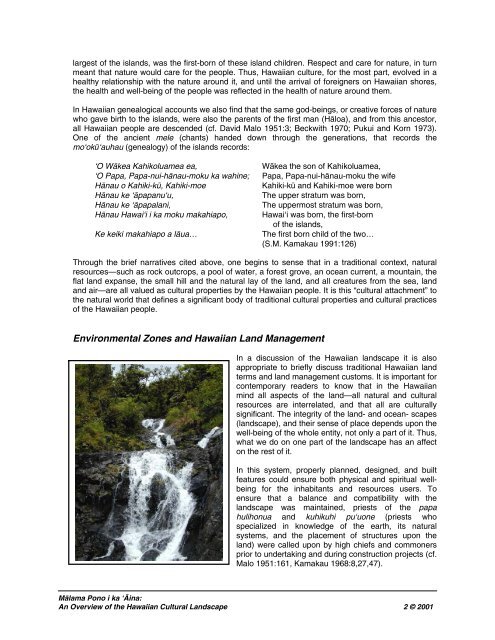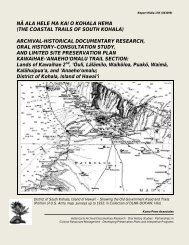The Hawaiian Cultural Landscape - Kumu Pono Associates
The Hawaiian Cultural Landscape - Kumu Pono Associates
The Hawaiian Cultural Landscape - Kumu Pono Associates
You also want an ePaper? Increase the reach of your titles
YUMPU automatically turns print PDFs into web optimized ePapers that Google loves.
largest of the islands, was the first-born of these island children. Respect and care for nature, in turn<br />
meant that nature would care for the people. Thus, <strong>Hawaiian</strong> culture, for the most part, evolved in a<br />
healthy relationship with the nature around it, and until the arrival of foreigners on <strong>Hawaiian</strong> shores,<br />
the health and well-being of the people was reflected in the health of nature around them.<br />
In <strong>Hawaiian</strong> genealogical accounts we also find that the same god-beings, or creative forces of nature<br />
who gave birth to the islands, were also the parents of the first man (Häloa), and from this ancestor,<br />
all <strong>Hawaiian</strong> people are descended (cf. David Malo 1951:3; Beckwith 1970; Pukui and Korn 1973).<br />
One of the ancient mele (chants) handed down through the generations, that records the<br />
mo‘okū‘auhau (genealogy) of the islands records:<br />
‘O Wäkea Kahikoluamea ea, Wākea the son of Kahikoluamea,<br />
‘O Papa, Papa-nui-hänau-moku ka wahine; Papa, Papa-nui-hänau-moku the wife<br />
Hänau o Kahiki-kü, Kahiki-moe Kahiki-kü and Kahiki-moe were born<br />
Hänau ke ‘äpapanu‘u, <strong>The</strong> upper stratum was born,<br />
Hänau ke ‘äpapalani, <strong>The</strong> uppermost stratum was born,<br />
Hänau Hawai‘i i ka moku makahiapo, Hawai‘i was born, the first-born<br />
of the islands,<br />
Ke keiki makahiapo a läua… <strong>The</strong> first born child of the two…<br />
(S.M. Kamakau 1991:126)<br />
Through the brief narratives cited above, one begins to sense that in a traditional context, natural<br />
resources—such as rock outcrops, a pool of water, a forest grove, an ocean current, a mountain, the<br />
flat land expanse, the small hill and the natural lay of the land, and all creatures from the sea, land<br />
and air—are all valued as cultural properties by the <strong>Hawaiian</strong> people. It is this “cultural attachment” to<br />
the natural world that defines a significant body of traditional cultural properties and cultural practices<br />
of the <strong>Hawaiian</strong> people.<br />
Environmental Zones and <strong>Hawaiian</strong> Land Management<br />
In a discussion of the <strong>Hawaiian</strong> landscape it is also<br />
appropriate to briefly discuss traditional <strong>Hawaiian</strong> land<br />
terms and land management customs. It is important for<br />
contemporary readers to know that in the <strong>Hawaiian</strong><br />
mind all aspects of the land—all natural and cultural<br />
resources are interrelated, and that all are culturally<br />
significant. <strong>The</strong> integrity of the land- and ocean- scapes<br />
(landscape), and their sense of place depends upon the<br />
well-being of the whole entity, not only a part of it. Thus,<br />
what we do on one part of the landscape has an affect<br />
on the rest of it.<br />
In this system, properly planned, designed, and built<br />
features could ensure both physical and spiritual wellbeing<br />
for the inhabitants and resources users. To<br />
ensure that a balance and compatibility with the<br />
landscape was maintained, priests of the papa<br />
hulihonua and kuhikuhi pu‘uone (priests who<br />
specialized in knowledge of the earth, its natural<br />
systems, and the placement of structures upon the<br />
land) were called upon by high chiefs and commoners<br />
prior to undertaking and during construction projects (cf.<br />
Malo 1951:161, Kamakau 1968:8,27,47).<br />
Mälama <strong>Pono</strong> i ka ‘Äina:<br />
An Overview of the <strong>Hawaiian</strong> <strong>Cultural</strong> <strong>Landscape</strong> 2 © 2001



